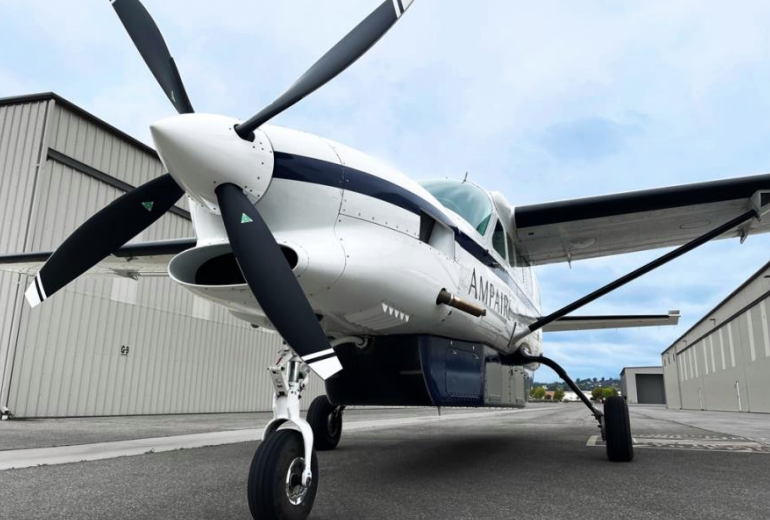FAA green lights Ampaire’s hybrid propulsion system with G-1 paper

Ampaire’s AMP-H570 hybrid electric propulsion system is a step closer to certification in late 2026 after the FAA approved its G-1 Issue Paper.
A first of its kind for a novel hybrid-electric propulsion system, the FAA approval defines the regulatory framework that the AMP-H570 must satisfy to achieve supplemental type certification (STC). The paper itself is split into four stages, Ampaire has completed all of them.
“It is wonderful to be hitting our marks along the road,” Kevin Noertker, co-founder and CEO of Ampaire told us in an interview ahead of the announcement. “The cool part of this experience is the ability to lay a foundation for what is going to be the next half a century of technology in this industry.
“The team here has worked so hard in not only building a system that’s certifiable, but building the relationships, the supply chain, all of the pieces and the entrenched environment around the milestone. Then the G1 is great because it’s effectively the roadmap for certification. The level of uncertainty around what’s going to be required of you is significantly reduced when you have the G1 finalised.”
With this approval, the Long Beach, California-based company advances to the next phase: working with the FAA to thresh out the means of compliance – aka a G-2 Issue Paper – and complete the testing campaign to validate the technology.
“It gives the common language for us to work with them on a common set of expectations. It also enables us to move on to the next stages, all the special conditions, all the means of compliance and then ultimately the test plans and getting the data required for certification.”
The FAA has given out many G-1’s – most recently in the novel propulsion space to ZeroAvia and MagniX – but never before for a hybrid-electric propulsion system. However, Noertker explains that no rewriting of the rule book has been required and all indications from the FAA suggest Ampaire will certify under Part 33.
“Figuring out where the guardrails are and working within them is the most generalisable process which helps Ampaire and the industry move a little bit faster in subsequent iterations rather than everything being a unique approach,” he adds.
Similar in principle to early hybrid cars, the AMP-H570’s hybrid architecture can recharge in-flight and does not require ground charging infrastructure. It is also retrofittable to a number of aircraft, with the first STC to be for the Cessna Caravan.
The AMP-H570 offers economic benefits including lower fuel consumption, reduced maintenance costs and extended aircraft service life. The system also supports compliance with tightening global emissions regulations.
Ampaire has conducted tests on the AMP-H570 using a 100% pure sustainable aviation fuel (SAF) from Dimensional Energy, creating a potential pathway for further emissions reductions.
Ampaire’s Cessna Eco Caravan, equipped with the AMP-H570, has already demonstrated more than double the fuel efficiency of its conventional counterpart during flight tests. The US Air Force has funded a research programme to apply the AMP-H570 into the King Air, and other aircraft manufacturers have begun exploring both Integrated Parallel Hybrid and Series Hybrid applications of the AMP-H570 into new aircraft designs.
Ed Lovelace, chief technology officer at Ampaire said: “Ampaire has worked for many years in close collaboration with our counterparts at the FAA. This productive dynamic has been instrumental in ensuring the highest safety standards while supporting the commercialisation of our impactful, innovative solutions.”
Noertker expands further on the relationship with US regulator. The work with the FAA on the G-1 began in 2023, but the first time Ampaire invited the FAA to witness testing was back in 2019 when the firm was trialling a Cessna Skymaster, he says.
“Over the course of years, we trained their safety personnel, we educated them on lithium-ion battery risks. We have really had a productive relationship not just on certification, but also more broadly about the preparedness of new technologies and our unique position as experts in those technologies. We’ve found that the FAA has been supportive of the process, that it’s not a black box, that this an organisation that has a clear mission and goals.”
As Noertker referenced earlier, the levels of uncertainty surrounding what will be required of a startup go down significantly when it gets a G-1 paper approval, particularly for investors.
After closing a Series A in early 2021 and receiving a $9m grant from the US Department of Energy in November 2022, Ampaire is looking to fill the remaining space in its latest funding round. That capital is set to see the company through to the certification of AMP-H570 in late 2026.
“Ampaire has brought in a little over $55m through a combination of venture capital investment from private investors, and government support in the form of contracts, research and development grants and such,” says Noertker.
Navigating a tricky funding climate (at the best of times recently) has been too much for a growing number of young companies. Arguably though, hybrid propulsion-focused aviation alongside AI-based and defence technology could begin to resemble a blessed trio of sectors in which investors are willing to readily deploy.
“Now we also see a lot of folks who were excited about electric and hydrogen in 2020 to 2022 are coming over to hybrid because they are looking for things that can cash flow sooner and do not have as high of a risk posture. Hybrid can also provide a nearer impact with a gateway open to long term too.”
Vertical Aerospace joined Archer and Joby on a growing list of eVTOL firms this week in announcing development of a hybrid variant of their eVTOL aircraft. “It’s definitely not a surprise, right? My strategy with Ampaire is to move fast enough that we’re going to be the supplier of choice at the end of the day.”
“Developers are going to have a make-buy decision and my goal is to make the buy decision compelling. An OEM might say: ‘We could probably eke out a few extra percent by customising it ourselves, but we should probably just go with Ampaire because they’ve got a million flight hours and already have the FAA approvals around the engines.
“Whether it’s for eVTOL or conventional planes, for propulsion or for onboard power,” he adds.
Subscribe to our free newsletter
For more deep dives from SAF Investor, subscribe to our email newsletter.






